Grebes are among the most specialized diving birds in the world. With their streamlined bodies, lobed feet, and striking seasonal plumage, they are masters of underwater hunting. In Michigan, six species of grebes have been recorded, ranging from common breeders to rare visitors. From spring migrations to summer nesting in cattail marshes, these birds add diversity and beauty to the state’s wetlands and lakes.
This guide introduces you to all six grebe species found in Michigan, where to see them, and how to identify their unique features in and out of breeding season.
1. Pied-billed Grebe (Podilymbus podiceps)
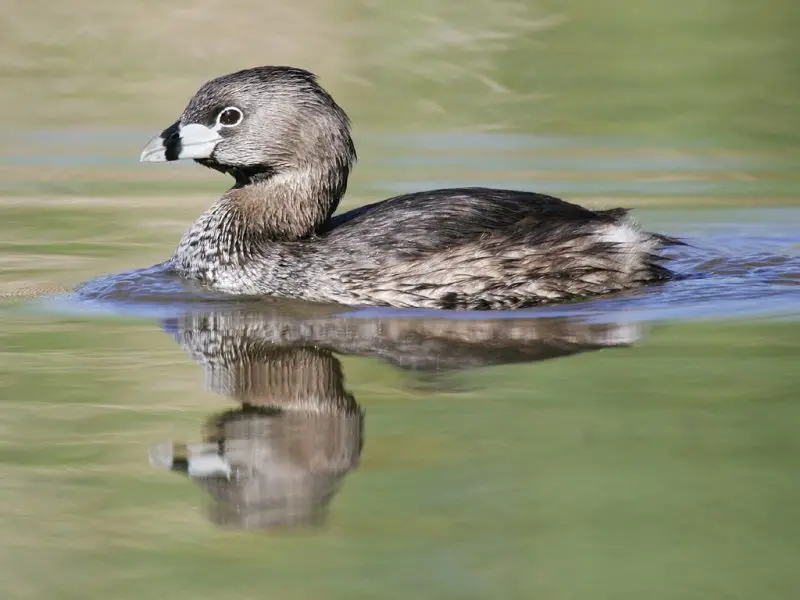
Michigan’s Most Widespread Grebe
If there’s one grebe you’re likely to spot in Michigan, it’s the Pied-billed Grebe. Found across the state from spring through late fall, this small, plump diver thrives in quiet wetlands—marshy ponds, slow-moving rivers, and shallow lakes where cattails and reeds provide both food and shelter. Unlike more secretive species, it is frequently seen paddling alone near the edges of vegetation or quietly slipping beneath the surface with barely a ripple.
During the breeding season, its distinctive hooting calls—low, echoing gulps—carry across the water like the voice of a hidden presence. Its name comes from the black ring encircling its pale bill, a unique field mark visible only in summer plumage. The bird’s overall coloring is modest: warm brown with a slightly paler belly, helping it blend in perfectly with the muddy shallows it calls home.
What makes this grebe especially interesting is its behavior. When disturbed, it almost never flies. Instead, it vanishes silently beneath the water, reappearing several meters away with just its eyes and crown exposed. It’s a stealthy survivor, perfectly suited to Michigan’s inland wetlands. Some individuals may even stay through the winter in the state’s southern regions—so long as there’s open, unfrozen water to dive in.
2. Horned Grebe (Podiceps auritus)
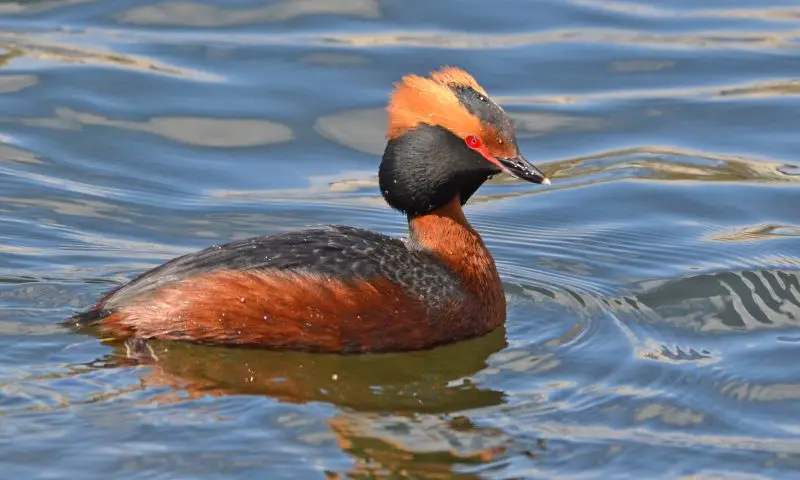
A Colorful Migrant with Golden “Horns”
Among Michigan’s migratory waterbirds, the Horned Grebe is a true seasonal jewel. Most often spotted during the peak of spring and fall migration, this striking species brings a flash of color and drama to inland lakes and Great Lakes shorelines. Though small in size, it demands attention with its vivid breeding plumage: a velvety black head, rich chestnut flanks, and two bold yellow tufts that sweep back like golden horns from its blazing red eyes.
These ornate feathers give the species its name and make it one of the most recognizable grebes during its brief stopovers in Michigan. Outside of the breeding season, however, the Horned Grebe transforms into a much more subdued bird, with grayish-black upperparts and white cheeks—more easily overlooked among waves and wind.
Horned Grebes do not breed in Michigan, but they pass through reliably in April and May, then again in September and October, resting and feeding in small flocks on open water. There, they dive frequently, disappearing beneath the surface with barely a splash before popping up yards away. Seeing them in full breeding colors is a seasonal treat—short-lived, but unforgettable for those who catch the moment.
3. Red-necked Grebe (Podiceps grisegena)
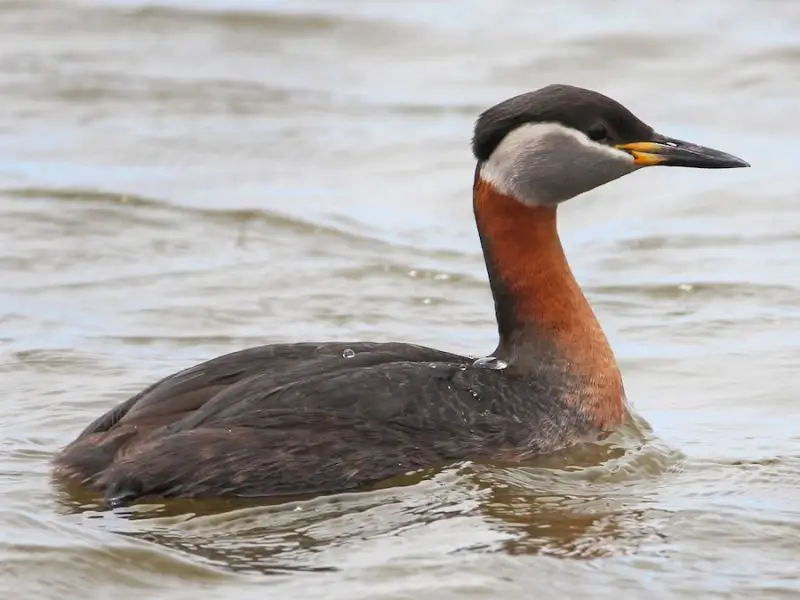
A Large Migrant with a Distinctive Call
With its elongated profile and confident presence, the Red-necked Grebe is one of the more impressive grebes to pass through Michigan. Slightly larger than the Horned Grebe, it is best recognized in spring by its deep chestnut-red neck, pale gray cheeks, and a thick yellow-based bill that stands out even at a distance. In winter, it trades these rich hues for a muted gray and white palette, blending more easily with cold northern waters.
Though this species breeds farther north in boreal lakes and wetlands of Canada, it reliably appears in Michigan during spring and fall migration, pausing on expansive bodies of water like Lake Michigan, Lake Huron, and large inland lakes. Red-necked Grebes often travel alone or in small groups, diving deep to feed on fish and aquatic invertebrates during their stopovers.
One of its most unique features is its voice—during the breeding season, the Red-necked Grebe lets out a raspy, drawn-out wail, often compared to a cross between a seagull and a loon. While this eerie call is rarely heard in Michigan, where the birds do not nest, it defines their presence in remote northern breeding territories. For Michigan birders, spotting this bold migrant—especially in its vivid spring plumage—is a moment of seasonal magic on the water.
4. Eared Grebe (Podiceps nigricollis)
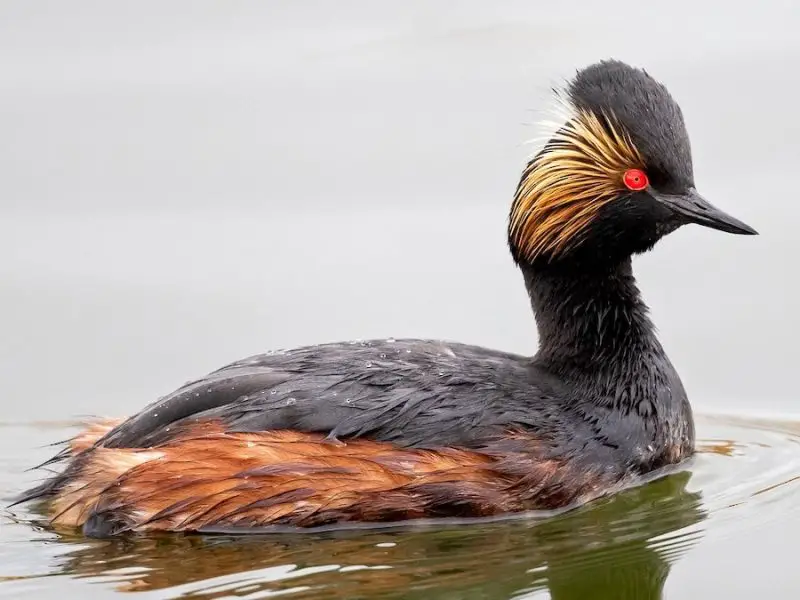
A Small and Striking Rarity
The Eared Grebe is perhaps the most eye-catching—and elusive—of Michigan’s grebes. Though small and compact, it transforms into a vivid spectacle during the breeding season. With its jet-black head, piercing red eyes, and sweeping golden ear tufts that curve like flames behind the eyes, this bird earns its name with dramatic flair. In non-breeding plumage, however, it becomes far more inconspicuous—grayish overall, with a pale face and darker cap—making it much easier to overlook.
In Michigan, the Eared Grebe is a rare migrant, usually appearing during spring and fall in scattered locations. Sightings tend to occur in southern regions or along the western shoreline of the state, where the birds stop briefly to rest and refuel on inland lakes. They dive frequently and are often spotted alone or in small, nervous groups far from shore.
Unlike in the western U.S., where Eared Grebes gather in massive staging flocks by the thousands before migration, Michigan hosts only modest numbers—making each encounter a special moment for observant birders. With its compact build and electric breeding colors, the Eared Grebe is a tiny rarity that lights up the water, if only for a fleeting season.
5. Western Grebe (Aechmophorus occidentalis)
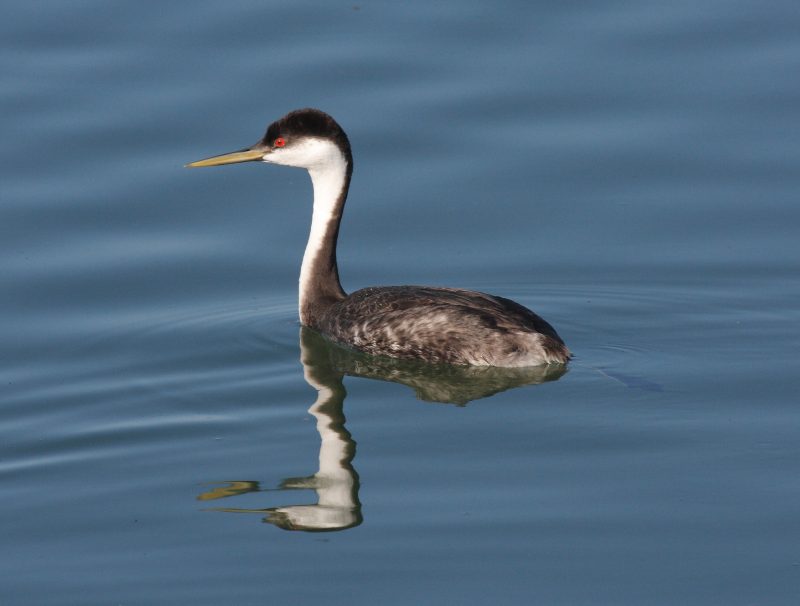
A Rare and Elegant Visitor
Graceful and unmistakable, the Western Grebe is a vision of elegance on open water. With its long, slender neck, crisp white face, and bold black crown, it cuts a striking silhouette as it glides low across the surface. Its dagger-like yellow bill and sleek, black-and-white contrast give it a regal, almost swan-like presence. Though native to the western U.S. and Canada, this species occasionally ventures far east—making its rare appearances in Michigan feel like a special occasion.
Western Grebes are built for aquatic life. They are superb divers, often disappearing beneath the surface for long seconds before reemerging far from where they began. But what truly sets them apart is their courtship ritual—a dazzling performance in which a pair rises side by side and “dances” across the water, their bodies upright and feet paddling rapidly in perfect unison. While these displays are typically seen on breeding grounds out West, even lone individuals in Michigan seem to carry the same poised charisma.
In Michigan, they’re considered rare vagrants, most likely to appear during fall or spring migration along the Great Lakes shorelines or large inland lakes. Their graceful form and unusual presence make them a high-priority sighting for dedicated birders scanning the horizon for something extraordinary.
6. Clark’s Grebe (Aechmophorus clarkii)
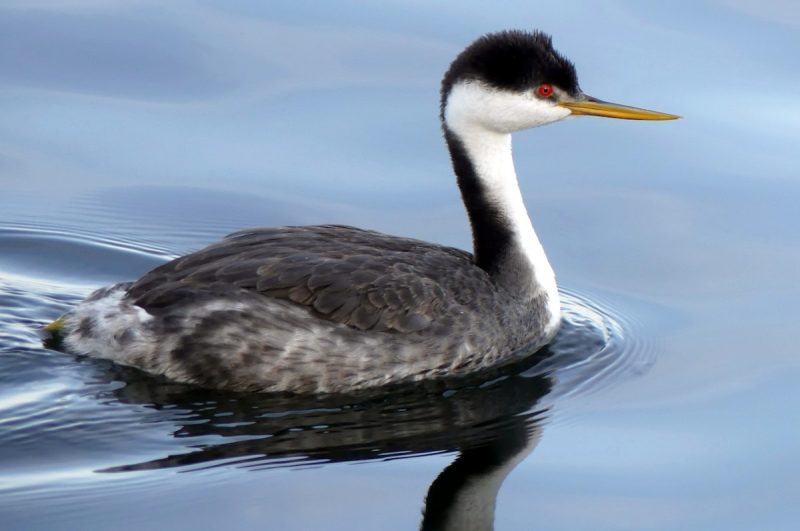
An Even Rarer Lookalike
Clark’s Grebe is the doppelgänger of the Western Grebe—but for sharp-eyed birders, the subtle differences between them mark the difference between rare and remarkable. With its brilliant white face, bright orange bill, and paler flanks, Clark’s Grebe has a slightly softer, more radiant look than its close cousin. From a distance, though, separating the two can be a real challenge, especially when they drift side by side on the same lake.
This species breeds almost exclusively in the western interior of North America, favoring large, shallow lakes and marshes. It is exceptionally rare in Michigan, typically turning up as a lone wanderer during late summer or early fall along the Great Lakes, often following strong weather systems or post-breeding dispersal patterns.
Whenever a Clark’s Grebe is reported in Michigan, it draws immediate excitement from the birding community. These sightings are rare enough that each one becomes a notable record, prompting scopes to swing and cameras to click as birders rush for a glimpse. Seeing one is not just a checklist moment—it’s a testament to the surprises nature still has in store for even the most well-explored landscapes.
Conclusion
Grebes are fascinating birds—masters of underwater hunting and displays of breeding-season drama. Michigan offers opportunities to see all six of North America’s grebe species at the right time of year, from the common Pied-billed Grebe nesting in local marshes to the elusive Clark’s Grebe drifting silently across a Great Lake.
Whether you’re a seasoned birder or a newcomer to waterbirds, keeping an eye out for grebes during spring and fall migration can lead to rewarding encounters. These sleek divers are not only indicators of healthy water ecosystems but also add depth and variety to Michigan’s already rich birdlife.






